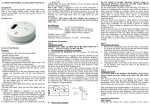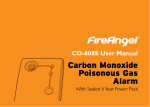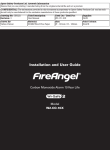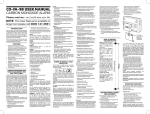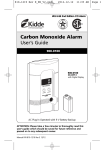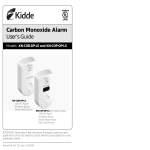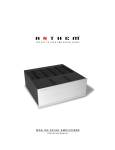Download Firex COZ-1 Owner's Manual
Transcript
Carbon Monoxide Alarm Owners Manual Model COZ-1 Owners Manual Model COZ-1 Model COZ-1 Item 6060 CAREFULLY READ AND UNDERSTAND THE CONTENTS OF THIS INSTRUCTION MANUAL BEFORE USING THE ALARM. STORE THE MANUAL IN A SAFE PLACE FOR FUTURE REFERENCE. PAY PARTICULAR ATTENTION TO THE SAFETY WARNINGS. PASS THE MANUAL ONTO ANY SUBSEQUENT USERS OF THE ALARM. WARNING Activation of your CO alarm’s audible buzzer indicates the presence of carbon monoxide (CO) which can KILL YOU. WARNING. THIS PRODUCT IS INTENDED FOR USE IN ORDINARY INDOOR LOCATIONS OF FAMILY LIVING UNITS. IT IS NOT DESIGNED TO MEASURE COMPLIANCE WITH OCCUPATIONAL SAFETY AND HEALTH ADMINISTRATION (OSHA) COMMERCIAL OR INDUSTRIAL STANDARDS. INDIVIDUALS WHO ARE AT SPECIAL RISK FROM CARBON MONOXIDE EXPOSURE BY REASON OF AGE, PREGNANCY OR MEDICAL CONDITION MAY CONSIDER USING WARNING DEVICES WHICH PROVIDE AUDIBLE AND VISUAL SIGNALS FOR CARBON MONOXIDE CONCENTRATION UNDER 30PPM. IF IN DOUBT CONSULT YOUR MEDICAL PRACTITIONER. THIS CARBON MONOXIDE ALARM IS NOT • Designed to detect smoke, fire or any gas other than carbon monoxide. • To be seen as a substitute for the proper servicing of fuel-burning appliances or the sweeping of chimneys. • To be used on an intermittent basis, or as a portable alarm for the spillage of combustion products from fuel-burning appliances or chimneys. CAUTION /Re Test set h Move air Alarm t o fr e s This carbon monoxide alarm is designed for indoor use only. Do not expose to rain or moisture. Do not knock or drop the alarm. Do not open or tamper with the alarm as this could cause malfunction. The alarm will not protect against the risk of carbon monoxide poisoning when the batteries have drained. The alarm will only indicate the presence of carbon monoxide gas at the sensor. Carbon monoxide gas may be present in other areas. IMPORTANT CARBON MONOXIDE ALARM • Carbon monoxide is produced by the incomplete combustion of fuels such as wood, charcoal, coal, heating oil, paraffin, gasoline, natural gas, propane, butane, etc. • Ideally, it is recommended that a carbon monoxide alarm should be installed in or near every room that has a fuel burning appliance such as any gas fireplaces, furnaces, room heaters, water heaters, cookers, grills, etc. Carbon Monoxide Alarm Owners Manual Model COZ-1 • Ensure that the alarm buzzer can be heard by all those who are intended to hear it. Seek medical help if it is suspected that a member of the household is suffering from carbon monoxide poisoning. • If the alarm sounds, make sure to investigate the problem. Ignoring the alarm may result in sickness, injury or death. (CO may be present even if nothing is seen or smelled by the user). • Alarm should be tested once per month. If further details are required which do not appear in this manual contact Climate Controls Americas. This pack contains: One alarm; Mounting kit; Owners manual; information label. 2109M5025 INTRODUCTION WHERE TO PUT THE ALARM Thank you for purchasing this Test/Reset alarm which is designed to Buzzer Button Alarm detect the presence of carbon monoxide. This manual contains information on the installation and operation of the CO alarm. The red light flashes at approximately 60-second intervals Gas inlet to indicate the alarm is operating correctly. The red light will flash continuously and the buzzer will sound if carbon monoxide is detected. The alarm is suitable for use in areas where cooking and heating appliances burn fuels such as wood, charcoal, coal, oil, gas, etc. Locate the top of the alarm no more than 6 feet from the floor. This carbon monoxide alarm is designed to detect carbon monoxide gas from any source of combustion. Ideally an alarm should be fitted in or near every room that contains a furnace or fuel burning heat source. However, if there is more than one appliance the following points should be taken into account: Bedroom Bedroom Bedroom Kitchen Living Room Garage Basement =Carbon Monoxide alarm location multi-level resistence IN WHICH ROOM TO PUT THE ALARM WHAT IS CARBON MONOXIDE? Carbon monoxide (CO) is a highly poisonous gas which is released when fuels are burnt. It is invisible, has no smell and is therefore very difficult to detect with the human senses. The first warning symptoms that CO is present in the air are usually headaches and nausea. Under normal conditions, in a room where fuel burning appliances are well maintained and correctly ventilated, the amount of carbon monoxide released into the room by appliances is not dangerous. A dangerous quantity of carbon monoxide can occur if one or more of the following conditions exists: 1. An appliance is faulty or is poorly maintained. 2. A flue is partially or totally blocked. 3. A room is not adequately ventilated. • An alarm should be installed in any family living unit containing a fuelburning appliance or fireplace or having an attached garage. • An alarm should be centrally located outside of each separate sleeping area in the immediate vicinity of the bedrooms. More than one alarm could be needed where bedrooms are separated and the audibility of the alarm to occupants within the bedrooms is impaired. WHERE NOT TO PUT THE ALARM Do not place the alarm in the following areas: • Outside the building. • In or below a cupboard. • In a damp or humid area. • Directly above a sink or stove/oven. The following conditions can result in potentially dangerous CO situations: 1. Excessive spillage or reverse venting of fuel burning appliances caused by outdoor conditions, such as: i) Wind direction and/or velocity; including high gusts of wind. Heavy air in the vent pipes (cold/humid air with extended periods between cycles). • Next to a door or window or anywhere that would be affected by drafts. • Where the air flow to the alarm would be obstructed by curtains or furniture. • When dirt or dust could collect and block the sensor, and stop it from functioning. ii) Negative pressure differential resulting from use of exhaust fans. • In an area where the temperature could drop below 40°F (4.4°C) or rise to above 100°F (37.8°C). iii) Simultaneous operation of several fuel burning appliances competing for limited internal air. • Where it could be easily knocked, damaged, or where it could be inadvertently removed. iv) Vent pipe connections vibrating loose from clothes dryers, furnaces or water heaters. • Within 5 feet (1.5m) of any cooking appliance. v) Obstructions in or unconventional vent pipe designs which can amplify the above situations. 2. Extended use of unvented fuel burning devices. 3. Temperature increase which can trap exhaust gases near the ground. 4. Car idling in an open or closed attached garage or near a home. SYMPTOMS OF CARBON MONOXIDE POISONING Carbon monoxide binds to the hemoglobin in the blood and reduces the amount of oxygen being circulated in the body. The following symptoms are related to CARBON MONOXIDE POISONING and should be discussed with ALL members of the household: Mild exposure: Slight headache, nausea, vomiting, fatigue (often described as “flu-like” symptoms). Medium exposure: Severe throbbing headache, drowsiness, confusion, fast heart rate. Extreme exposure: Unconsciousness, convulsions, cardiorespiratory failure, death. Many causes of reported CARBON MONOXIDE POISONING indicate that while victims are aware that they are not well, they become so disoriented that they are unable to save themselves by either exiting the building or calling for assistance. Also young children and pets may be the first to be affected. Consult a physician if any symptoms are experienced. CARE AND MAINTENANCE OF ALARM The alarm should be tested monthly by pressing and holding the test/reset button on the front of the alarm for several seconds. The alarm is pre-calibrated at the factory and requires no maintenance other than to clean the outside casing occasionally with a cloth. Ensure that the holes on the front of the alarm are not blocked with dirt and dust. DO NOT USE CLEANING AGENTS, BLEACH OR POLISH. The unit requires 3 x 1.5V alkaline batteries. The following are suitable replacements: Gold Peak 24A LR03, Energizer E92 LR03 Use only the batteries listed. Use of batteries not listed may affect performance of the unit. USING THE DETECTOR To activate the detector, pull the red tab. The red light will flash briefly and the buzzer will sound a short chirp. If this doesn’t happen please check battery installation. Press the test/reset button and check that the red light flashes and the buzzer sounds. The detector is now operating and ready for use. Normal Operation OPERATION OF THE ALARM WALL MOUNTING INSTALLATION The alarm is not fitted with an on/off switch, it is automatically switched on when the tab is removed. This is to ensure that the alarm cannot be inadvertently switched off and therefore fail to detect a build-up of carbon monoxide. Red Light Buzzer WHAT TO DO WHEN THE ALARM SOUNDS The alarm is designed to be wall mounted using the hardware provided. Find a position to install the alarm (see “Where to put the alarm” and “Where not to put the alarm”). mounting pad When no carbon monoxide is present, the red light will flash approximately once every 60 seconds. Option 1 Special Mounting Pad with Nail (supplied) Place the nail through the mounting pad. Using a hammer, gently knock the nail into the wall ensuring that the mounting pad is not hammered too firmly into the wall. 1 every 60 secs 1. Operate reset/silence button. nail wall insert Test / Reset Button (in Normal operation) If required, the alarm operation can be checked for correct operation by pushing the Test/Reset button on the front of the unit. First sequence: 4 flashes 4 beeps 5mm Option 2 Screw and Insert (NOT supplied) If the wall is too hard to use the nail, use a No. 4 round head screw and insert. screw wall Second sequence: 4 flashes 4 beeps Press the test/reset button on the front of the alarm, hold for several seconds and check that the red light flashes and the audible alarm sounds. The detector can be hung on the protruding nail using the ‘keyhole’ on the back. WARRANTY INFORMATION Alarm Conditions When the unit detects carbon monoxide the alarm signal is sounded continuously. The red alarm light will flash and the alarm will sound approximately 4 times every 5 seconds. When the unit has been in alarm for a period of approximately 4 minutes, the alarm signal will be given every 60 seconds. Test / Reset Button (in Alarm condition) If required, the audible alarm signal can be silenced for a period of 6 minutes by pushing the Test/Reset button on the front of the unit. The red light will continue to flash. If the carbon monoxide is still present after the 6 minute period, the audible alarm will resume the previous alarm condition. The Test/Reset button should not be used repeatedly and the actions “What to do when the alarm sounds” should be followed. Return to Normal Operation When the carbon monoxide gas disperses, the alarm will stop. The red light will flash approximately once every 60 seconds (normal operation). The user should check for the source of CO any time the alarm has sounded, even if the alarm has returned to its normal working conditions. Battery Replacement / Fault Warning When the batteries need replacing the unit will sound 1 short beep once every 60 seconds. The batteries must then be replaced. The red light will flash once as normal. If the detector continues to sound 1 short beep every 60 seconds it must be replaced. Room spaces should be well ventilated when household cleaning supplies are used as these may cause a false alarm. If problems with this alarm cannot be resolved, contact: Technical Support: (800) 445-8299 Monday–Friday 7:30AM–5:30PM CST Your COZ-1 Carbon Monoxide Alarm (excluding batteries) is warranted for 5 years from date of purchase against defect in materials and workmanship under normal use. 4 every 5 secs 4 every 60 secs 4 every 5 secs 4 every 60 secs 4 beeps every 5 secs 4 beeps every 60 secs no beep for 6 minutes 4 beeps every 60 secs The manufacturers liability is limited to the repair or replacement of any part of the alarm which is found to be defective in materials or workmanship under normal use during the applicable period from date of purchase. The replacement product will be in warranty for the remainder of the original warranty period or for six months, whichever is longer. The warranty is void if the product has been damaged by accident, unreasonable use, neglect, tampering or other causes not arising from defects in materials or workmanship. 2. Call your emergency service (Phone: _______________________________) [fire department or 911]. 3. Immediately move to fresh air – outdoors or by an open door/window. Do a head count to check that all persons are accounted for. Do not re-enter the premises nor move away from the open door/window until the emergency services have arrived, the premises have been aired out and your alarm remains in its normal condition. 4. After following steps 1-3, if your alarm reactivates within a 24-hour period, repeat steps 1-3 and call a qualified technician (Phone: _______________________________) to investigate for sources of CO from fuel burning equipment and appliances and inspect for proper operation of this equipment. If problems are identified during this inspection have the equipment serviced immediately. Note any combustion equipment not inspected by the technician and consult the manufacturers’ instructions, or contact the manufacturers directly, for more information about CO safety and this equipment. Make sure that motor vehicles are not and have not been operating in an attached garage or adjacent to the residence. SELF - ADHESIVE LABELS Please add the telephone number of your emergency services and a qualified technician to the labels provided and place one copy next to the appliance and the other near a source of fresh air where you plan to gather in the event of an alarm. TO REPLACE BATTERIES The manufacturer makes no warranty, expressed or implied, written or oral, including that of merchantability or fitness for any particular purpose, with respect to the batteries. Pull down catch to open detector and pull ribbon to remove batteries. The manufacturer makes no other express warranty for this alarm. No agent representative, dealer or employee of the manufacturer has the authority to increase or alter the obligations or limitations of this warranty. Carefully remove old batteries from battery housing and dispose of old batteries with care. In no case shall the manufacturer be liable for any consequential or incidental damages for breach of this or any other warranty, expressed or implied whatsoever, even if the loss or damage is caused by the company’s negligence or fault. The manufacturer shall have no liability for any personal injury, property damage or any special, incidental, contingent or consequential damage of any kind resulting from gas leakage, fire or explosion. Some states do not allow limitation on how long an implied warranty lasts and/or do not allow the exclusion or limitation of accidental or consequential damages so the above limitation or exclusion may not apply to you. This warranty gives you specific legal rights and you may also have other rights which may vary from state to state. 1 every 60 secs WARNING Activation of your CO alarm’s audible buzzer indicates the presence of carbon monoxide (CO) which can KILL YOU. Using only batteries listed in 'Care and Maintenance of Alarm' insert 3 new batteries, ensuring they snap securely into place and cannot be shaken loose. When inserting the batteries, ensure the polarity is correct - ie: positive end of battery (+) aligns with the (+) symbol in the battery housing. Press the test/reset button and check that the red light flashes and the buzzer sounds. The detector is now operating and ready for use. NOTE: WITH THE BATTERIES REMOVED IT WILL NOT BE POSSIBLE TO CLOSE THE ALARM LID. Any products in need of repair should be returned to: In the U.S.: In Canada: Climate Controls Americas Climate Controls Canada, Inc. 28C Leigh Fisher Blvd 3505 Laird Road - Unit #14 El Paso, TX 79906 Mississauga, Ontario L5L 5Y7 Please include a note clearly describing the problem when you return the alarm. 1 every 60 secs 1 beep every 60 secs SPECIFICATION Model: Gas Detected: Detection Principle: Alarm Indication: Alarm Levels: COZ-1 Carbon monoxide Electro-chemical cell Audible and visual alarm 70ppm Between 60 and 240 minutes 150ppm Between 10 and 50 minutes 400ppm Between 4 and 15 minutes Operating Temperature: 40°F to +100°F Humidity Range: 15 to 95% RH Warm-up time after initial switch on:Instantaneous Dimensions: 4.69” x 3.14” x 1.50” Weight: 6oz. DISPOSAL Dispose of the alarm in accordance with local regulations. WARNING: DO NOT DISPOSE OF IN FIRE. Should you experience difficulty in obtaining a replacement alarm contact:


